Are you looking for the most cost-effective way to lift weights without having to go to the gym? Then this is the post for you! Because today, I will be exploring the cheapest ways to lift weights at home.
The cheapest way to lift weights at home is resistance band training (costing $0.44 per kg resistance). At $130 a set, suspension trainers and power towers are also affordable options for home bodyweight training. Dumbbells and barbells cost $2.80 per kg resistance but offer superior cost-effectiveness in the long term.
10 years ago I was that skinny kid in his garage, equipped with nothing but a rusty old barbell.
I wanted to get big without having to go to the gym and knew that if I wanted to reach my goal, then I needed to upgrade my arsenal.
The problem?
Money of course!
So here are the 6 most cost-effective ways to lift weights at home (something I wish I knew myself back then!).
Let’s jump right in!
- Best Weight Lifting Exercises For Skinny Guys To Build Muscle
- The 6 Cheapest Ways To Lift Weights At Home
- 1. Suspension Trainers Are Cheap And Effective.
- 2. Power Towers Are Cheap But Specialised
- 3. Resistance Bands Are The Cheapest!
- 4. Kettlebell Costs Can Mount Up!
- 5. Dumbbells Are Cost-Effective.
- 6. Barbell Cost-Effectiveness Reigns Supreme.
- Conclusion
Best Weight Lifting Exercises For Skinny Guys To Build Muscle
When it comes to weight lifting for skinny guys, compound lifts are your best friend.
These are also known as the “big lifts”. And there’s a reason why they have that nickname.
Because they lead to big gains!
Compound lifts are weight-lifting exercises that require multiple muscle groups to be activated. Additionally, they will typically involve movement around multiple joints.
The 5 core lifts are the classic examples of the compound lifts:
| Weight Lifting Exercise | Muscles Engaged | Joints Engaged |
|---|---|---|
| Bench press. | Pectorals, triceps, anterior deltoids. | Shoulder, elbow. |
| Overhead press. | Anterior deltoids, posterior deltoids, lateral deltoids, triceps, core. | Shoulder, elbow. |
| Bent-over row. | Trapezius, rhomboids, latissimus dorsi, biceps, posterior deltoids. | Shoulder, elbow. |
| Squat. | Quadriceps, hamstrings, gluteus maximus, gastrocnemius, core. | Knee, hip. |
| Deadlift. | Quadriceps, hamstrings, gluteus maximus, gastrocnemius, core, trapezius, deltoids, rhomboids. | Knee, hip, shoulder. |
These exercises will give the biggest bang for the buck if you are a skinny guy trying to gain muscle at home.
Therefore the cheapest way to EFFECTIVELY lift weights at home will require equipment that allows you to perform these exercises (or variations of them).
This is what I will be exploring next.
Check out my other article to learn more about compound exercises!
The 6 Cheapest Ways To Lift Weights At Home
Here are 6 of the cheapest ways in which you can lift weights at home.
If you are a skinny guy, then all 6 of these methods will help you to gain muscle.
I have assigned a score for each method based on their long-term benefits for muscle gains and cost per kg of weight provided.
Some methods have a cheaper initial cost, whilst other options are more cost-effective over the long term.
I have also given you an example of how they can be used to gain muscle at home.
So choose a method that is suitable for your current (and future) needs!
| Weight Lifting Method | Advantages | Disadvantages | Cost Per Kg Resistance | Score |
|---|---|---|---|---|
| Suspension Trainer. | 1) Maximises leverage for bodyweight lifting. 2) Work stabilizer and core muscles. 3) Cheap. 4) Convenient. | 1) Limited opportunity to increase weight. 3) Steep learning curve. | $130 for a full set. | 7/10 |
| Power Tower. | 1) Cheap. 2) Good for upper body-weight lifting. 2) Space-saving. | 1) Limited exercises. 2) No good for the lower body. | $110 for the tower. | 6/10 |
| Resistance Band. | 1) Extremely cheap. 2) Can replicate all compound lifting exercises. 3) Unique resistance curve. 4) Convenient | 1) Dangerous at high resistance. 2) Difficult to quantify weight. 3) Requires motivation. 4) Very susceptible to wear and tear. | $0.44 per kg. | 8/10 |
| Fixed-Weight Kettlebell Set (excluding bench). | 1) Cheaper than a barbell set. 2) Versatile exercises. 3) Trains core strength. 4) Trains functional strength. | 1) Difficult to leverage heavy weights. 2) Large weight increments. 3) Expensive for what they offer in terms of building significant muscle mass over the long term. | $3.00 per kg. | 7/10 |
| Dumbbell Bar + Plates (excluding bench). | 1) Cheap to increase weight. 2) Versatile. 3) Easy to use. 4) Small weight increments. | 1) Comes with a learning curve. 2) Weight cap at around 45kg per dumbbell. | $2.80 per kg. | 9/10 |
| Barbell + Plates (excluding bench and rack). | 1) Extremely versatile. 2) Cost-effective and long-term way to build muscle at home. 3) Accommodates heavy loads. 4) Flexible weight increments. | 1) Rack and bench will bump up the price. 2) Can be dangerous for beginners’ training solo. | $2.80 per kg. | 9/10 |
1. Suspension Trainers Are Cheap And Effective.

A suspension trainer is a Y-shaped belt that offers an affordable and effective way to maximize the results of home bodyweight training.
The stalk of the Y attaches to an anchor point. From here, the ends of the fork in the Y-shape hang down with handles. And these allow you to grab onto them with your hands or insert your feet.
From this basic setup, you now have a platform to leverage your own weight to perform a range of push/pull body weight lifts.
Check out my other article to find out your ideal training duration!
Cost Per Kg Resistance Of Suspension Trainers:
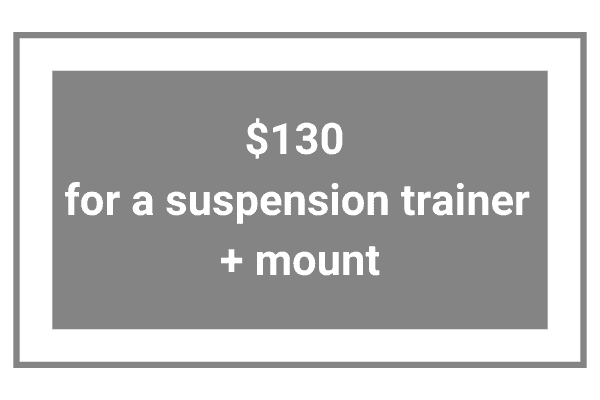
The cost per kg of resistance cannot be reliably calculated for suspension trainers. That’s because they work on your body weight.
But suspension trainers can be found for around $100 for a set. You will also probably want to buy a ceiling mount for another $30.
This will take the total to $130 for a complete suspension training set.
From this, you can perform full-body workouts at home.
Advantages Of Suspension Trainers:

The main advantages of suspension trainers are:
- An affordable way to maximize bodyweight lifting- bodyweight exercises are the cheapest way to lift weights. There’s no doubt about that. And not only are they cheap, but they are also extremely effective. In fact, you may be surprised at how difficult it can be to lift your own body weight!
- Provide flexibility to body weight lifting- restricted workout angles are the main downside of performing bodyweight training without equipment. As a result, it can be hard to target specific muscles as you can do with free weights. Suspension trainers offer a cheap way to exploit the angles and leverage required for you to effectively perform bodyweight exercises at home.
- Engage stabilizers and core- suspension trainer exercises are inherently unstable. And this makes them great for engaging the stabilizer and core muscles.
- Convenient- suspension trainers are lightweight and have a small footprint. Use them anywhere. And store them anywhere!
Disadvantages Of Suspension Trainers:
The main disadvantages of suspension trainers are:
- Low-resistance cap- suspension trainers are a cheap, effective, and convenient way to lift weights at home. But they do not offer much in the way of increasing resistance levels. In other words, you are restricted to lifting your own body weight only. This means that after you reach a certain strength level, it can be harder to continue building muscle with suspension trainers. And you may have to invest in free weights.
- Hard to use- suspension trainers aren’t the most beginner-friendly way to lift weights at home. In fact, they can be rather hard to use. This is due to the inherent instability of the exercises, which require a great deal of work from your core and stabilizer muscles.
Example Home Workout With A Suspension Trainer:
Find a secure ceiling to install a mount.
This will allow you to attach your suspension trainer. And from here, you can do compound exercises that target the muscles in your entire body.
If you do not wish to install a ceiling mount, you can also attach them to a closed door.
This will still be an effective setup. But will offer slightly less flexibility in terms of achieving a specific lifting angle.
Other alternatives include:
- Garage beams.
- Park climbing frames.
- Fence pillars.
Final Verdict On Suspension Trainers:
7/10.
Suspension trainers provide a cheap way to effectively lift your body weight at home. And you can use them to replicate all the important compound movements.
This makes them incredibly good value for home bodyweight workouts.
But due to their steep learning curve, they aren’t great for skinny beginners.
2. Power Towers Are Cheap But Specialised
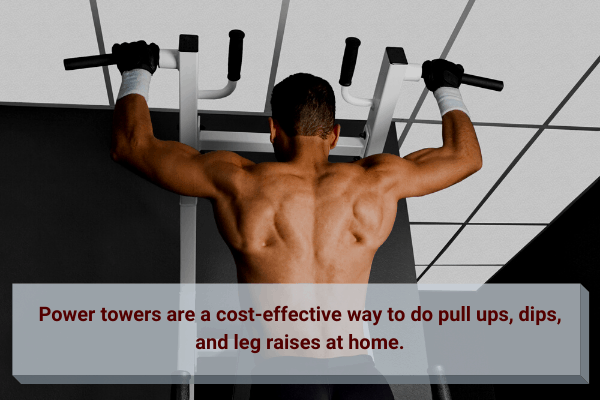
A Power tower is the fancy name for an all-in-one pull-up/dip station.
There is a horizontal bar at the top of the frame which allows you to do pull-ups and chin-ups. These are excellent exercises to build your back and arms at home.
There are also two handles in the middle portion of the frame which will allow you to do dips. And dips are an awesome way to train your arms and lower chest.
The pull-up bar can also be used to do exercises such as the hanging leg raise. And this will work your lower abdominals.
You can go to my other article to find out how dips can build chest muscle.
Cost Per Kg Resistance Of A Power Tower:
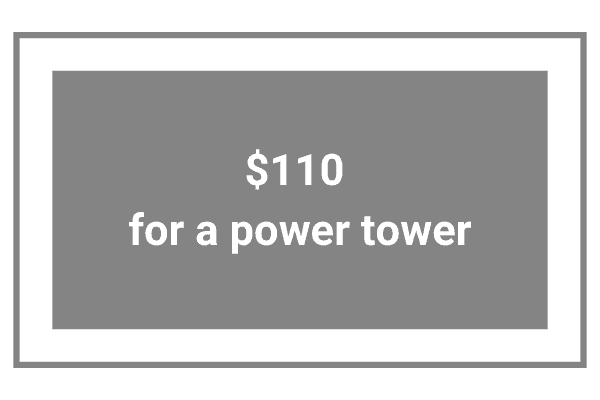
As with suspension trainers, the cost per kg of resistance cannot be reliably calculated for power towers (which are used for body weight lifting).
But a decent power tower can be found for around $170 dollars.
You can also find ones even cheaper than this. But from my experience, these can be flimsy. Additionally, the cheaper ones may not provide the height required for your body to fully clear the ground.
So make sure you research the material and measurements before buying a power tower!
Advantages Of A Power Tower:

The main advantages of using a power tower are:
- Affordable- power towers are an affordable way to do pull-ups, dips, and leg raise. Your other alternative would be to invest in separate pull-ups and dip bars. And these will often add up to be more expensive than the power tower.
- Upper body compound lifting– the power tower is the ideal piece of home gym equipment to do upper body-weight lifting. The three exercises in which the power tower is designed for- pull up, dip, and leg raise- are hard to perform without bars. Therefore the power tower is an excellent piece of equipment to supplement a home body weight lifting program.
- Space-saving design- the power tower is a compact design, being taller than it is wide. This makes it ideal for home gym setups where space is limited.
Disadvantages Of A Power Tower:
The main disadvantages of using a power tower are:
- Limited exercises- power towers are more supplementary equipment than all-inclusive equipment. They are great for what they are designed for (pull-ups, dips, leg raises). But aside from that, they have little use.
- Do not cater to lower body exercises- the power tower will not help you to perform leg exercises at home.
Check out my other article to learn how to do your first pull up!
Example Home Workout With A Power Tower:
As I mentioned earlier, the power tower is more of accessory equipment for a home workout.
Place it in a corner of the house where space permits. And use this as your pull-up/dip/leg raise station.
Then you can use the surrounding space for other body weight lifting exercises such as:
- Press ups.
- Crunches.
- Pistol squats.
- Bulgarian split squats.
- Nordic ham curls.
Check out my other article to learn more home workouts to build muscle!
Final Verdict On A Power Tower:
6/10.
The power tower is no doubt a cheap way to do upper body weight lifting at home. Furthermore, the exercises it is designed to facilitate are excellent muscle builders.
However, it’s also a very specialized piece of equipment. The fact that it won’t facilitate lower body development is a major negative.
So in terms of value, you may want to spend your money elsewhere.
I mainly use it for pull-ups.

But it’s also great for chest dips too.

3. Resistance Bands Are The Cheapest!

Resistance bands are basically giant elastic bands that you can pull and push on.
They come in a variety of different shapes and sizes. But they all perform the same job.
The most common forms are flat bands and tube bands.
Flat bands are joined on either end as a continuous loop. And they can be up to a few inches wide (depending on resistance level).
Tube bands have a tubular shape and come unjoined. But both ends will usually have carabiner clips that allow you to join the band into a circular loop. Most resistance bands will also come with attachable handle grips.
Looped or un-looped, resistance bands allow you to replicate the compound weight-lifting movements of free weights.
Cost Per Kg Resistance For Resistance Bands:
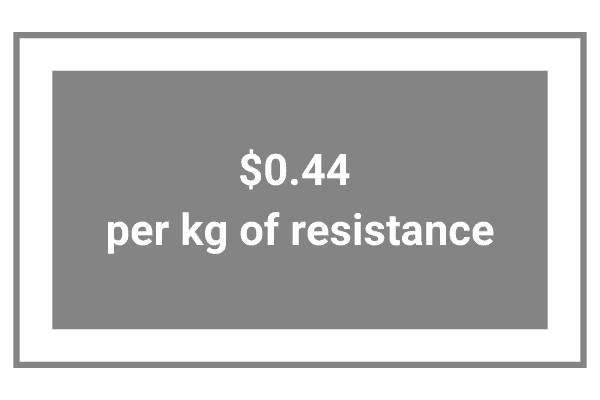
Resistance bands are one of the cheapest ways to lift weights at home.
A set of bands will typically cost a mere $30. And this will include a selection of bands with varying resistance levels.
The bands can reach combined resistance levels of up to 150lbs, and even more (for premium sets).
But from my personal experience, the resistance feels much greater than the advertised resistance (that’s a good thing!).
This is due to the fact that a band’s resistance will significantly increase the more it stretches.
If you assume a combined resistance of 150lbs (68kg), that results in just $0.44 per kg of resistance!
You won’t get much cheaper than that when it comes to lifting weights at home!
Advantages Of Resistance Bands:
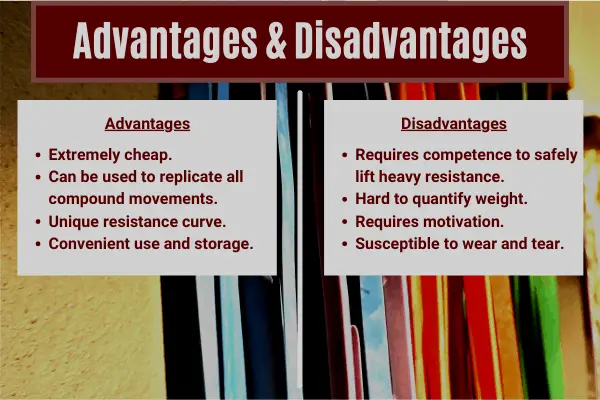
The main advantages of using resistance bands are:
- Extremely cheap way to lift weights- at only $0.44 per kg of resistance, bands reign supreme when it comes to affordability! Moreover, the level of resistance provided is not low either. Don’t judge a book by its cover. Bands may feel flimsy, but it will take you years of training until you are strong enough to overcome the combined resistance in a full set of bands!
- Can replicate all compound weight lifting movements- bands can be used to replicate all of the compound weight lifting movements you would normally do with free weights. Combined with their cheap price tag, resistance bands are an extremely cost-effective way of lifting weights at home.
- Different resistance curves- resistance bands provide a unique resistance curve. As you would expect, resistance increases as the band is stretched. Take advantage of the upper resistance curve and you can use bands to gain muscle just as effectively as free weights.
- Convenience- you can’t get more convenience than a set of elastic bands! They’re light, and portable, and you can use them anywhere.
Disadvantages Of Resistance Bands:
The main disadvantages of using resistance bands are:
- Requires competence to safely lift heavy- at heavy loads, you will need to be careful. You don’t want a band to slip and snap back towards the body (trust me!). Therefore resistance bands need a degree of mastery before you attempt a heavy resistance.
- Hard to quantify weight- unlike free weights, resistance bands do not have quantifiable resistance. Yes, bands are clearly marked with different resistance levels. But the resistance, in reality, will change as the band stretches. A 25lb band can provide a higher resistance than a 50lb band, if stretched enough! This can make it hard to judge whether or not you are getting stronger at home.
- Requires motivation- as a result of being hard to quantify the weight, resistance bands often require a degree of discipline and motivation. I personally get bored very easily when using resistance bands at home.
- Susceptible to wear and tear- bands are usually made from latex (known to be very durable). But they will always be less durable than free weights. Once a rip or tear forms, it won’t be long until the band snaps completely. Then you will have to buy another set. This is the downside to the initial affordability of resistance bands.
Example Home Workout With Resistance Bands:
As long as you have a location to secure your band, you can literally do any exercise you want.
Additionally, most sets will come with attachable door mounts and handles. If not, you can always buy them separately at a very reasonable price.
Ways to secure a band include:
- Hand.
- Feet.
- Door.
- Beams and bars.
- Railings.
- Climbing frames.
Final Verdict On Resistance Bands:
8/10.
Resistance bands are without a doubt the cheapest way to lift weights at home. Just make sure you look after them. This will ensure you don’t go through multiple sets, and thereby increasing the total cost.
Not only are they affordable, but they also allow you to do all the compound exercises at home. Youtube has a wealth of tutorial videos to learn how to do the different exercises.
The resistance levels provided by bands are enough for even the most seasoned gym-goer to gain muscle. So as a skinny guy, you can definitely use them to gain muscle at home.
That being said, will you have the motivation to use bands in the long term? (they can be quite boring to use).
If so, then I highly recommend the Undersun bands.
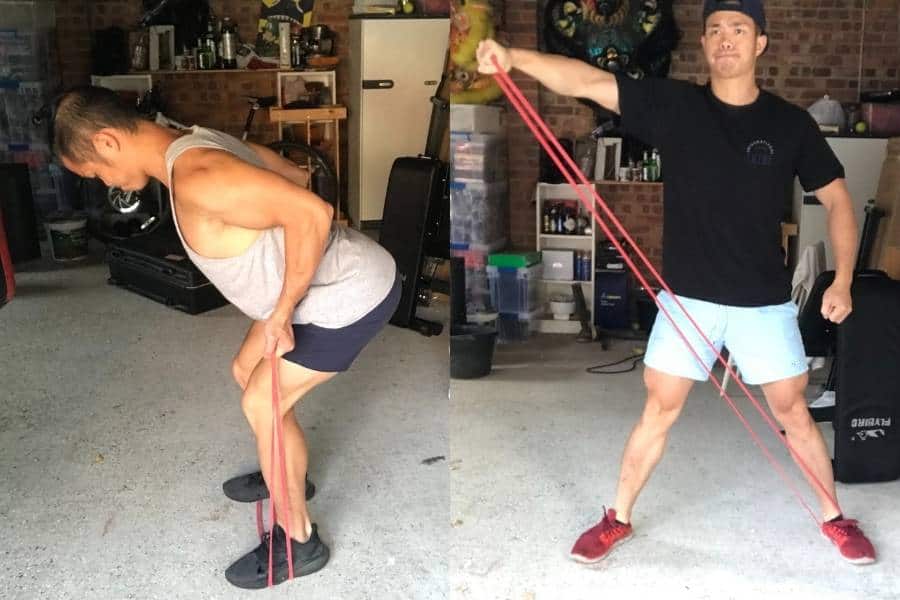
They’re a bit more expensive than your average bands.
But having had 2 cheap sets snap on me in the past, I can only recommend spending a bit extra for the Undersuns.
They are durable and are the only models that come with a lifetime warranty (as far as I know).
You can use them as they are, but from my experience, cheap gloves like these Ihuans will protect your hands from friction burns.
This allows you to lift heavier resistance for a better workout.
4. Kettlebell Costs Can Mount Up!

A kettlebell is a weighted ball with a handle.
They can come as a set of fixed-weight kettlebells, or as a single adjustable kettlebell.
Fixed-weight kettlebells are usually made out of cast iron and can be coated in materials such as rubber or urethane (these are usually more expensive).
Adjustable kettlebells come as a single kettlebell with a clicker setting to vary the weight.
Both will allow you to perform compound weight lifting at home.
Cost Per Kg Resistance Of Kettlebells:

The cost per kg of resistance will vary greatly depending on whether you choose an adjustable kettlebell or a fixed-weight kettlebell set (see below).
| Adjustable Kettlebell (4.5kg to 18kg) | Kettlebell Set (12kg, 16kg, 20kg, 24kg) | |
|---|---|---|
| Price per set. | $150.00 | $145.00 |
| Price per Kg. | $11.00 | $3.00 |
The most cost-effective way to buy home kettlebells will be as a fixed-weight set. For around $145, you will get a set of kettlebells weighing 12kg, 16kg, 20kg, and 24kg.
At a combined weight of 72kg, that equates to $3.00 per kg of resistance.
But please note that the prices will vary depending on the supplier and brand.
So shop around!
Another point to note is that you will also want to invest in a weight bench to get the most from your kettlebell workouts.
A weight bench will cost around $100 and allow you to effectively work out the chest at home.
Advantages Of Kettlebells:
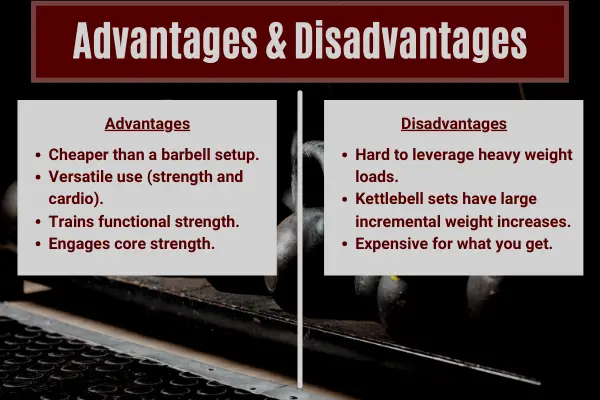
The main advantages of kettlebells are:
- Cheaper than a barbell set- a set of kettlebells is usually much cheaper than a barbell/rack set. But they will be more expensive than a dumbbell set.
- Versatile- kettlebells are very versatile pieces of weight-lifting equipment. They will allow you to do all variants of the compound lifts if your goal is to build muscle at home. They will also allow you to do whole-body cardio exercises if you want to burn fat at home.
- Functional strength- due to the awkward shape of the kettlebell, they replicate the movements you would perform in your everyday activities. This makes them great for increasing functional strength.
- Core strength- kettlebell exercises are inherently unstable. They often require a high degree of stabilization from the core to hold the movements. This makes them great for engaging the core as you work the other muscles simultaneously.
Disadvantages Of Kettlebells:
The main disadvantages of kettlebells are:
- Hard to leverage heavy weight loads- the awkward shape of the kettlebell can make them hard to grip for beginners. This will limit the amount of weight you can safely lift at home.
- Large weight increments- kettlebells have large incremental increases in weight (unlike weight plates which have a small incremental increase in weight). This means you may have to spend more money to get a variety of kettlebells with your desired range of weights.
- Expensive for what they are- if your sole focus is on building muscle, then kettlebells can be expensive for what they offer. That’s because you will likely have to purchase more kettlebells as your strength progresses.
Example Home Workout With Kettlebells:
Find a location that has enough space for a weight bench and around 3sq meters of surrounding floor space.
Most kettlebell workouts can be completed in open floor space. And you can use the bench to perform exercises that specifically target the chest and back.
The bench can also be used for leg exercises such as the box squat and Bulgarian split squat.
Final Verdict On Kettlebells:
7/10.
Kettlebells seem cheap on paper and they can be effective at building muscle at home.
But the costs can quickly mount up.
If your goal is to build muscle, then you will probably have to buy a lot of kettlebells (with a range of weight loads) in order to mitigate the issue of the large weight increments.
Not only will this become expensive, but you will also require a huge deal of space to store your kettlebells. This can be a problem with kettlebells, which have awkward shapes that make for difficult storage.
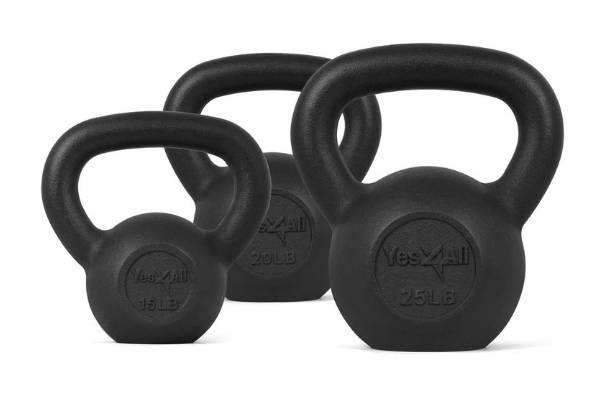
If this is something that you can accept, then I highly recommend the Yes4All kettlebells.
They’re reasonably priced and provide enough weight for beginners to get started.
5. Dumbbells Are Cost-Effective.
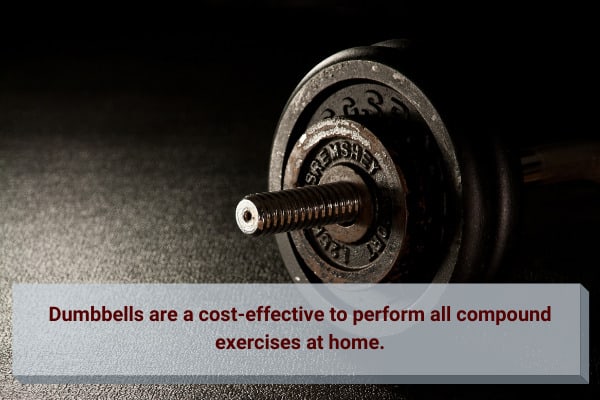
A dumbbell is a weighted bar that can be held with one hand.
Two popular variations exist these days- adjustable dumbbells and dumbbell bars with adjustable plates.
Adjustable dumbbells come as a single unit, with a setting to adjust the weight.
Dumbbell bars with adjustable plates come as a standalone bars. And from here, you can add/remove weight plates to make your desired weight.
Both will allow you to perform compound weight lifting at home.
Read my other article to learn how to lift weights to build muscle!
Cost Per Kg Resistance For Dumbbells:
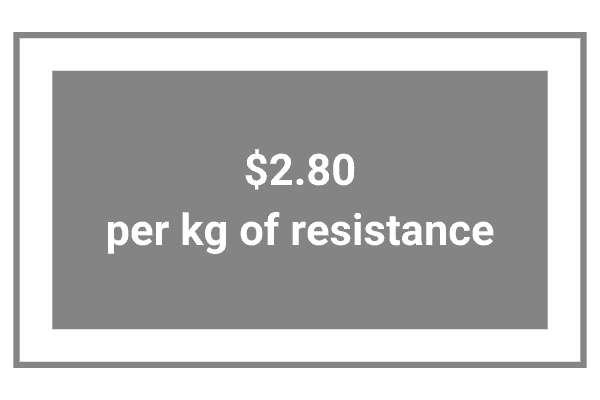
Depending on which dumbbell variation you choose, the costs can vary greatly (see below)
| Adjustable Dumbbell (2 x 25kg) | Dumbbell Bar With Plates (2 x 25kg) | |
|---|---|---|
| Price per set. | $420 | $140 |
| Price per Kg | $8.40 | $2.80 |
The cheapest way to use dumbbells at home is to buy a dumbbell bar with adjustable plates.
For around $140, you can get a pair of dumbbell bars with a selection of weight plates that total up to 50kg. That equates to $2.80 per kg of resistance.
As with all free weights, prices can vary a lot depending on the supplier and brand.
So shop around!
You will also need a weight bench (around $100) to get the most from your home dumbbell workouts.
For more price data, you can check out my other article to find out the average cost of different dumbbells.
Advantages Of Dumbbells:
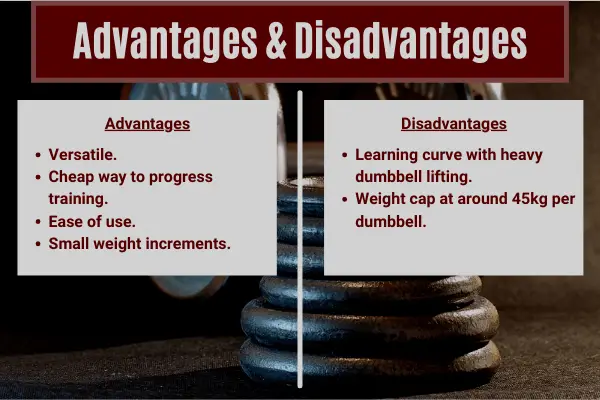
The main advantages of dumbbells are:
- Versatile-you can pretty much do any pushing and pulling exercise with a pair of dumbbells. Additionally, these exercises can work the entire body. This makes dumbbells an extremely versatile way to lift weights at home.
- Cheap to progress in your training- dumbbells are relatively cheap for the advantages they offer. Unlike kettlebells, it’s easy and relatively cheap to continue adding weights to your dumbbell. This will allow you to keep progressing as you become stronger. Buy a dumbbell bar with the capacity for adding weights. This will future-proof your dumbbell.
- Ease of use- dumbbells have a simple and sleek ergonomic design that allows you to lift them in a variety of angles and ranges of motion. This allows you to target all the muscle groups in your body.
- Small weight increments- dumbbell plates have small increments. This allows you to progressively add weight in a safe manner. Simply add 2kg every few weeks to become stronger and bigger!
You may also be interested in my other post for different ways to build a V-shaped body at home!
Disadvantages Of Dumbbells:
The main disadvantages of dumbbells are:
- Learning curve- dumbbells are inherently more unstable than a barbell, and they will require your stabiliser muscles to control the movement. As a beginner, you may initially struggle with heavy weights.
- Weight cap- dumbbells have a much lower weight capacity than a barbell. This means that up to a certain point, you may have to upgrade to a barbell. Your alternative would be to find ways of making your dumbbell exercises harder to perform.
Example Home Workout With Dumbbells:
To do an effective dumbbell workout, all you really need is space for your bench.
The dumbbells themselves are compact pieces of equipment.
From here, you will be able to do a variety of home dumbbell exercises that target all the muscles in the body.
Final Verdict For Dumbbells:
9/10.
In terms of cost-effectiveness, you can’t beat the humble dumbbell.
They are cheap, convenient, and allow you to perform all the compound exercises needed to build muscle at home.
If you buy a dumbbell bar with the capacity to add more weight, you will also be able to use your dumbbell for the long term.
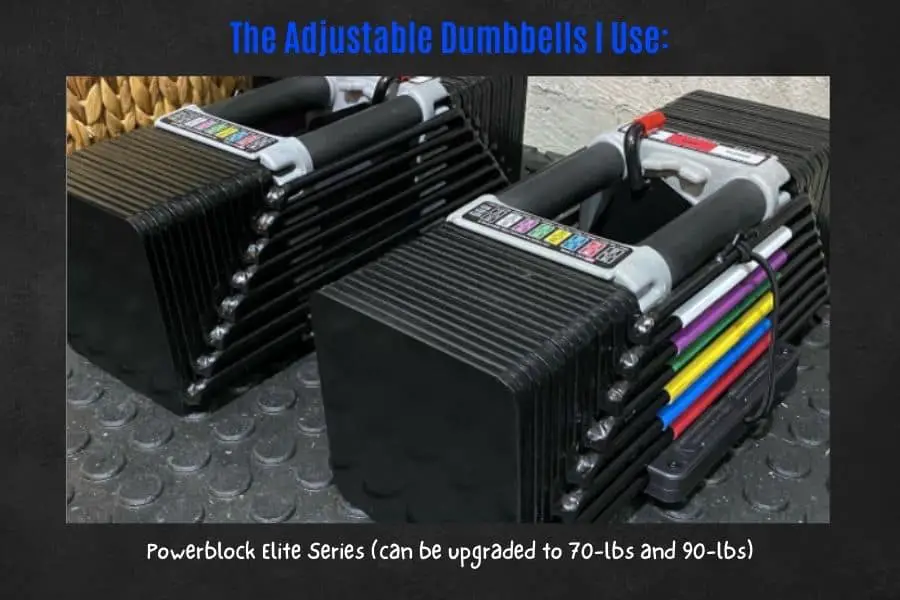
I personally use the Powerblock Elites.
They pack an entire set of weights into a single adjustable unit, making for great value lifting.
If you’re looking for a basic budget option, then the Yes4All spinlock dumbbells are also good for beginners.
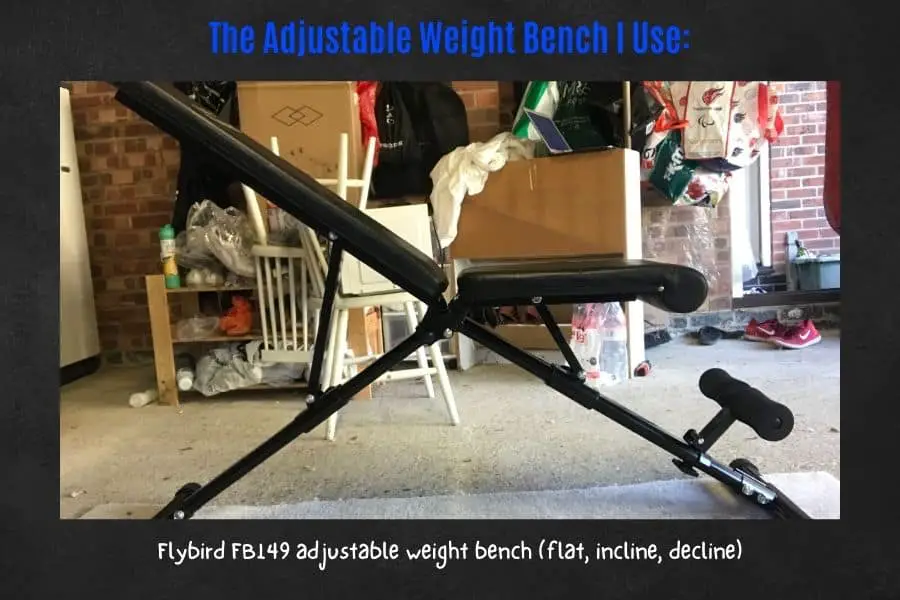
Both dumbbells work great with the Flybird adjustable bench to train the chest, back, and abs.
6. Barbell Cost-Effectiveness Reigns Supreme.
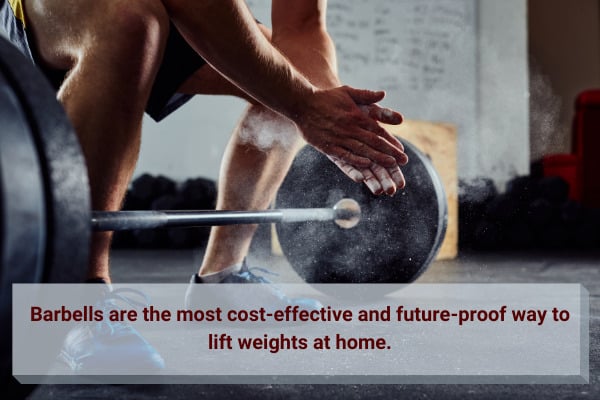
A barbell is a long steel bar that allows you to add weights on both ends.
The bar is standalone, and you will need to buy the weight plates separately.
In addition t the barbell and weight plates, you will also need a bench and a rack.
Combined, these 3 pieces of equipment will allow you to perform all the compound weight-lifting exercises at home.
Check out my other article to learn about the essential equipment for a home gym!
Cost Per Kg Resistance For A Barbell:

In terms of initial startup cost, the barbell is one of the more expensive ways to lift weights at home.
But a barbell setup will last you a very long time, with no requirement to upgrade your equipment in the short/mid-term future.
A budget Olympic-sized barbell (weighing 20kg alone) will cost around $80.
In addition to this, you will need weight plates. And 150kg of plates (which will last most beginners for the first few years of training), will cost another $400 or so.
This takes the total to $480 for 170kg of total weight. And this equates to $2.80 per kg of resistance.
You will also need a rack and a bench if you want to gain the most benefits from barbell weight lifting at home.
A cheap rack will cost around $100 and the bench another $100.
You can find the average cost per lb/kg of barbell plates here in my other article.
Advantages Of A Barbell:
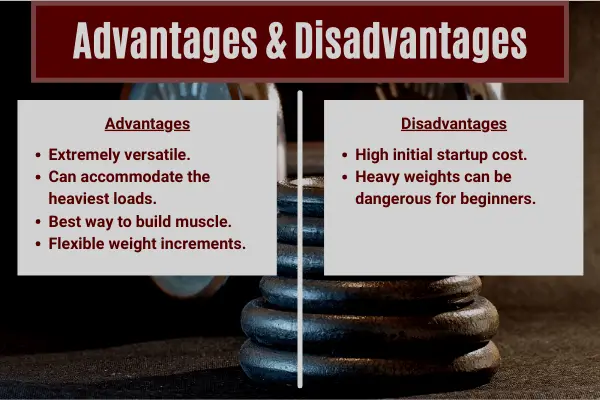
The main advantages of using a barbell are:
- Extremely versatile- barbells can be used to train every major muscle group in the body. And the 5 main compound lifts (bench press, overhead press, row, squat, and deadlift) are based on the barbell. Additionally, you can load them weigh a low weight or extremely heavy weight.
- Accommodate heavy loads- barbells are king when it comes to loading on heavy weights. A barbell will be able to accommodate all the weight you will ever need to lift in your lifetime, making them extremely future-proof.
- Most cost-effective way to build muscle at home- the startup cost may be high. But the long-term usability and capabilities to handle heavy weight loads make barbells the most cost-effective way to build serious muscle mass at home.
- Flexible weight increments- barbell weight plates can be as small as 2.5kg and as big as 25kg per plate. This makes them ideal to progress for people of all abilities.
Disadvantages Of A Barbell:
The main disadvantages of using a barbell are:
- High initial startup cost- to make your home barbell training safe and effective, you will also need to invest in a bench and rack. Combined with the weight plates, the costs can stack up. Having said that, this initial investment will most likely last you a lifetime of training.
- Can be dangerous for beginners- the capability to stack on high-weight loads can make the barbell dangerous for inexperienced people lifting weights at home. You should practice with light weights. And ideally have a training partner to spot you when lifting heavy weights.
Example Home Workout With A Barbell:
You will need to find a space of approximately 3-4 square meters.
This will allow you to fit a bench and a rack.
You will also need additional floor space to do barbell exercises from the ground.
Once you have this setup, you will be able to perform all the compound weight-lifting exercises at home.
Final Verdict For A Barbell:
9/10.
A home barbell-rack-bench setup is without a doubt the most cost-effective way to lift weights at home in the long run.
The only reason why home barbell lifting has not scored a solid 10 is due to the requirement for the rack and bench.
These will add substantial costs to your home weight-lifting setup.
But if you are willing to make the initial investment, you will pretty much have everything you need to lift weights at home (now and well into the future).
When you consider the amount of money you can save from gym memberships, a home barbell setup is worth every penny!
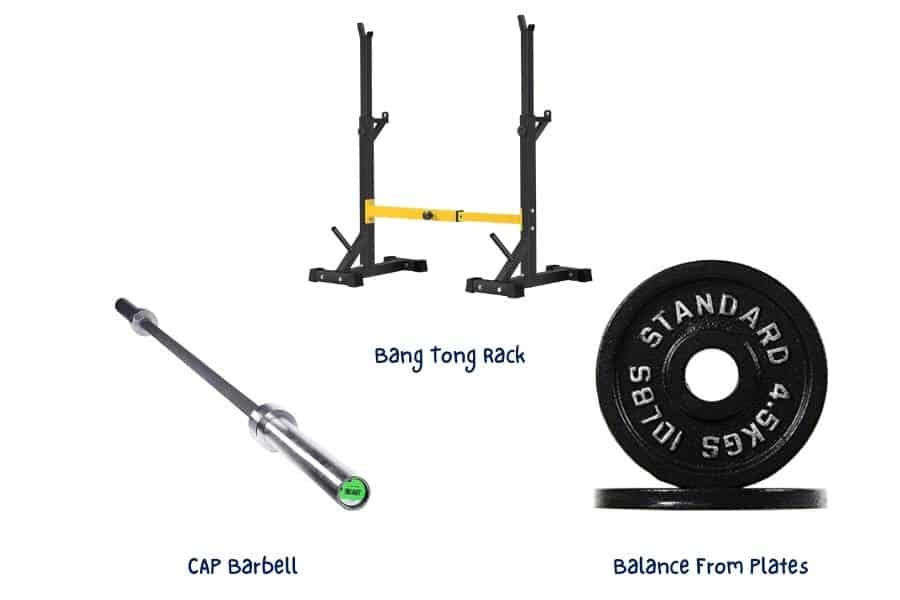
I’ve tried and tested the CAP Olympic barbell and found it be cheap but durable. It goes well with the Balance From cast iron plates, Bang Tong rack, and Flybird bench.
You can check out my other article which explains the cost-effectiveness of home gyms!
Conclusion
That’s it!
Today, I have explored the cheapest ways to lift weights at home.
In terms of short-term affordability, you can’t beat a set of resistance bands (at a mere $0.44 per kg of resistance). Not only are bands cheap, but they will also allow you to replicate all the weight-lifting movements of free weights.
But in terms of long-term affordability and cost-effectiveness, I would strongly recommend investing in free weights.
Dumbbells and barbells are both relatively cheap, at $2.80 per kg of resistance.
But the recommended benches and racks will hike up the price for both.
That being said, a well-planned dumbbell/barbell setup will allow you to gain significant muscle mass at home (now and into the future).
What is your favorite method of lifting weights at home?
Feel free to send me a message if you have any questions! You can find my details on the “contact us” page.
You may also be interested in the downloadable Kalibre Blueprint PDF which details exactly how I gained 40lbs of lean muscle (it’s 100% free!). It details the exact exercises and nutrition (with printable worksheets) I used to go from skinny to ripped!
Thanks for reading guys!
Peace Out,
Kal
(Biochemistry BSc, Biomedical Sciences MSc, Ex-Skinny Guy)


